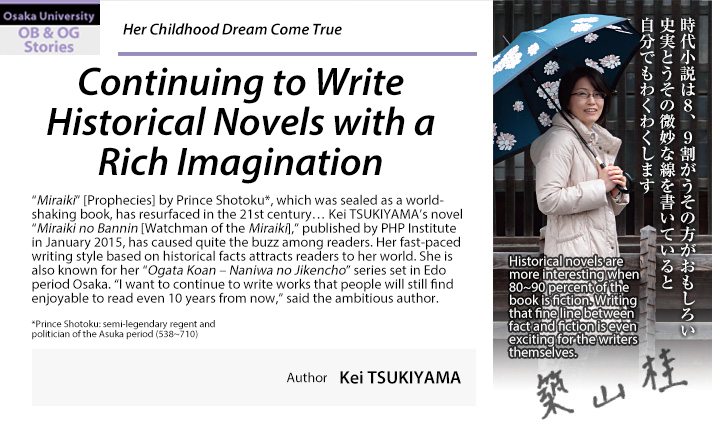
Kei TSUKIYAMA (Author)

Weaving stories with threads of history
Many of Ms. Tsukiyama’s works are set in Osaka during the Edo Period. She’s liked historical
TV dramas ever since she was a child. “I loved
samurai period dramas
with lots of sword fighting, like ‘
Hissatsu
Shigotonin
.’ It was exciting to see worlds completely
removed from the everyday,” said Ms. Tsukiyama. What solidified her love for
historical pieces was “
Moeyo Ken
,” a
novel by Ryotaro SHIBA that depicted the Shinsengumi, a special police force of the
shogunate government in the late Edo Period. Drawn in by the appeal of the
Shinsengumi, she read comics and novels about the group, and even toured
historical sites related
to the group in Kyoto.
Ms. Tsukiyama entered the School of Letters at Osaka University. She says that she was entranced by ancient texts as a student. Revealing a bigger historical picture by piecing together historical facts, kind of like a jigsaw puzzle, was thrilling to her.
“I was more interested in the lives of everyday people in the Edo period than the people in power. I’m sure that the people of that time had strong awareness that they couldn’t leave things to the government and had to do something to support themselves. I wanted to write about those kinds of common folk.”
Aiming to become a writer while in graduate school
After receiving her bachelor’s degree, she began research on modern Japanese history in graduate school. Researchers must pursue the truth in their research, but novelists can use their imagination to create stories, so she decided to become a writer.
“I incorporate fact and fiction into my novels so that readers aren't quite sure where the fiction ends and the facts begin. If I can make readers think that my story might be true, I feel that I've done my job!
Readers sometimes ask her how much of her books are indeed true, but just as one would expect from an author, she simply responds with, “I’ll leave that to your imagination.”
However, the road to
becoming an author had its bumps. She applied for
prizes
awarded to new or upcoming authors since she was in graduate school, but was rejected every time. A turning point for her came in 1998, when an editor and acquaintance of Ms. Tsukiyama published her novel, “
Naniwa no Kaze
.”
In the wake of good reviews in the newspaper, she began to receive writing offers from publishers.
She
drew attention for her
novel featuring OGATA Koan
Author Kei TSUKIYAMA became well-known in 2009 when her
novel
featuring OGATA Koan entitled “
OGATA
Koan – Naniwa no Jikencho
(OGATA Koan – Naniwa [Case
Files])” was dramatized and broadcast over several episodes on NHK.
Koan was the founder of Tekijuku, a school for
Dutch studies and the origin of Osaka University. “There are a lot of novels
featuring famous Osakans in the Edo period, like IHARA Saikaku and CHIKAMATSU
Monzaemon, people you could find in a high school history textbook, but hardly those
featuring Koan. So I thought, why not write one myself? This may sound like hindsight, but I’m a
graduate of Osaka University, so perhaps it was fate that I would write this novel.”
Currently, she’s enjoying
her life as a novelist
who can use her imagination to create stories.”
To
collect information for a novel, she’s also been learning
to
play the musical instrument used in
Tennoji gagaku
,
ancient
court music of Japan passed down in a single family in Osaka from the time of Prince
Shotoku. She works out the structure of the
novel by looking at old newspapers, texts, and diaries from the Edo period and by
just walking around town. She enjoys creating the worlds of her stories from a single line of an ancient text by stretching
her imagination.
She’s never fallen
into a slump,
but there have been times when she’s nearly lost sight of the appeal of historical pieces.
On such occasions, she makes a point of
watching “
Hissatsu Shigotonin
.”
“I get a lot of inspiration from these kinds of ‘anything
goes’
period dramas.”
Edo period Osaka is likely to be her main battleground from the time being.
To current students
Ms. Tsukiyama clearly
remembers the response she received from her
former teacher Professor WAKITA Osamu (now Professor Emeritus) when she mentioned that she wanted to
become an author
: “Sounds interesting!” Prof. Michito MURATA (Graduate School of
Letters) also showed his support, saying, “Work hard so that your juniors can
boast of a graduate who can write novels.” She feels that
she is here
as an author because of support from her former teachers.
So, she wants current
students to be “flexible”
individuals
who do not simply fit into an existing mold. Currently,
in Japan, emphasis tends to be placed on practical and useful knowledge, but she wants Osaka University
to be a university that allows these “flexible” students to thrive.

● Kei TSUKIYAMA
Born
Kayoko YAMAGUCHI, Ms. Tsukiyama graduated from the School of Letters, Osaka
University in 1992. She received credits in the doctoral program at OU in
modern Japanese history. She made her writing debut in 1998, and has written a
number of historical novels set in Edo period Osaka.
She has
written 34 works, including
Tenmon Goyo Juichiya
and her latest work,
Miraiki
. The NHK Saturday
Historical Drama “
Naniwa no Hana –
Ogata Koan Jikencho
” was based on a work by Ms. Tsukiyama. She likes playing the
ancient musical instrument
sho
(traditional Japanese woodwind).
This is a reprint of the article posted in the Osaka University NewsLetter No. 67 (March 2015).